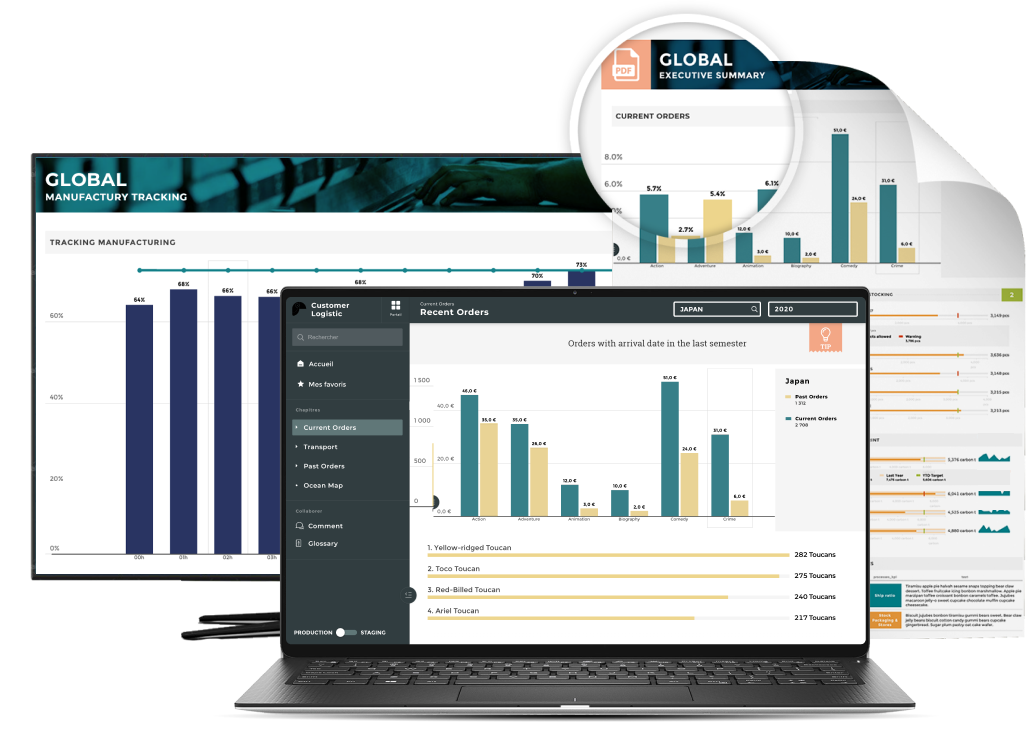
Defining Real Estate KPIs
Real Estate KPIs (Key Performance Indicators) are quantifiable measures used to evaluate progress toward a set goal in the context of the real estate industry. These metrics help real estate leaders identify weaknesses, analyze things like performance or investment potential and, ultimately, make better data-driven decisions.
Given the size and competitiveness inherent to the real estate industry, it's unsurprising that most individuals and businesses in the spaces have come to rely heavily on KPI tracking to not only monitor sales data, but also key indicators of the health of leasing, management, and property development processes.
While there is a virtually unending list of real estate KPIs, for varying contexts, this article will look at some of the most widely used and impactful ones, as well as some of the benefits leading companies are seeing from their use of real estate KPI dashboards.
9 KPIs COMMERCIAL REAL ESTATE MANAGERS SHould TRACK
KPI #1 – REVENUE GROWTH
One of the most obvious yet impactful KPIs to monitor as a real estate manager is revenue growth, comparing results year over year and, where deemed necessary, over other time periods. Adhering to data storytelling best practices is an excellent way to leverage important metrics like revenue growth, granting the ability to understand and intelligently respond to any uncovered trends.
.webp?width=440&name=Capture-d%E2%80%99e%CC%81cran-2019-04-23-a%CC%80-18.14.33%20(1).webp)
Most everyone wants more revenue, which typically correlates with higher net profit. That's why it's important to track (and share) monthly, quarterly, and annual revenue growth. You'll want to monitor your performance, compare it to market conditions, and share it with business stakeholders (ideally via an automated or embedded dashboard).
KPI #2 – RENT PRICES
Regular comparison of your average rent with market rates is essential if you want to stay competitive. Effective monitoring and optimization of this KPI will protect you from both losing out on tenants because of things like archaic pricing structures, as well as losing out on potential revenue from undervaluing your properties.
If your rent price positioning is good, it can become an effective way to help improve your average occupancy rates.
And, if relevant, giving investors access to this information will allow you to prove (or disprove) your pricing positioning and strategy.
KPI #4 – TENANT TURNOVER
More often than not, finding new tenants costs a lot more (as much as 3-4x) than renewing an existing lease. So, if you want to be successful in the real estate space, it's vital that you track tenant turnover so you can quickly identify and remedy factors that contribute to high turnover.
The average tenant turnover is generally between 12 to 24 months in urban markets and 24 to 48 months in peri-urban or rural areas. The point here is: understand what average turnover rates are for a given property and make sure that yours is roughly aligned (or better) than it. Either way, you'll want to understand why your turnover rates are what they are; if you have a good tenant turnover rate, understanding (and perhaps replicating) contributing factors will improve your success in the long run, and similarly important is analyzing why you have poor tenant turnover rates. Are rents too high for your market? Are the repairs up to date?
This KPI is another solid indicator of the sustainability of your management practices.
KPI #5 - OCCUPANCY RATE
Your income is entirely dependent on how much of your property is rented, so this KPI should be top of mind. At the end of the day, 100% of your income depends on rented properties.
Occupancy rate is another metric that, in an ideal world, will align with (or beat) averages, but even small improvements in occupancy rates can make or break your business.
Consistent improvements in occupancy rates are reflective of good retention and tenant attraction strategies, and may even indicate an opportunity to take further action like increasing rent prices.
Negative changes in occupancy rates, on the other hand, likely signify poor management strategies that have made your properties become less appealing.
KPI #6 – FOOTFALL RATIO AND CONVERSION RATES
Footfall refers to the measurement of the number of people entering a given location and will be obviously relevant for commercial real estate managers who work with retail spaces (like malls).
This KPI is typically measured on an hourly, daily, and/or weekly basis with the intention of optimizing store performance, conversion rates, and high-traffic periods.
This data can be used in many ways, such as sharing with tenants to incentivize lease renewal and support them in building their marketing and sales strategies.
KPI #7 – REPAIR AND MAINTENANCE COSTS
Repairs and maintenance represent a major component of most property management budgets, making it another vital, potentially cost-saving KPI to monitor. Understanding your repair and maintenance costs uncovers ways to improve process efficiency, improve the hiring of outside workers, and handle your accounts more effectively.
KPI #8 – TENANT ACQUISITION COST
This KPI begs a simple question: how much do you, on average, have to spend to obtain new tenants? This helps you understand how cost-effective your strategies are, and points to where you can improve marketing and labor expenses (related to acquiring new tenants).
KPI #9 – AVERAGE ARREARS
Another key challenge facing property managers is getting their tenants to pay them on time. Arrears indicate how much you're owed, and are obviously important to track given that they directly (and significantly) impact your cash flow which you need to maintain success.
High average arrears are a red flag as far as growth is concerned, and how effective you are at collecting rent is indicative of how successful you will be in the long term.
A Last Word
While we've covered some of the KPIs that most retail managers track, there are loads of others you'll want to keep in mind (this article from Buildium covers some great ones).
At the end of the day, data in and of itself is useless. Making it actionable is one of the only ways you'll be able to improve your business, and one way to do this is with data storytelling. Let's recap some of the highlights of data storytelling in the real estate context:
- Using data storytelling dashboards improves productivity. With automated reports, you and your team can focus on your core business instead of on data collection, manipulation, and the like.
- Data storytelling dashboards ensure access to homogeneous and reliable data for all stakeholders. This reduces the risk of miscommunication.
- Data storytelling dashboards help to establish transparency and more effective communication with your stakeholders.


.webp?width=440&name=Capture-d%E2%80%99e%CC%81cran-2019-04-23-a%CC%80-15.54.14%20(1).webp)
.webp?width=440&name=Capture-d%E2%80%99e%CC%81cran-2019-04-23-a%CC%80-15.40.46%20(1).webp)




